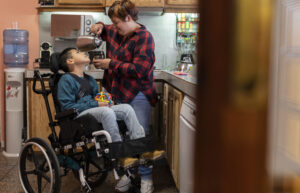Individuals with intellectual, developmental, and physical disabilities are more likely to experience traumatic experiences than individuals without a disability (i.e., Rumball, 2020; Hulbert-Williams et al., 2014; Soylu et al., 2013). For instance, approximately 45% of individuals with autism report symptoms of post-traumatic stress disorder (PTSD; Rumball, 2020). Adults with intellectual disability are more likely to experience physical, emotional, and sexual abuse than typically developing adults (Soylu et al., 2013).
Children with disabilities experience higher rates of maltreatment and are more likely to experience more than one type of abuse compared to typically developing children (i.e. Jones et al., 2012; Maclean et al., 2017). Additionally, if there are impairments in their intellectual functioning and adaptive skills, those with disabilities are often less able to process traumatic events (McCarthy et al., 2017).
Family members, including caregivers, siblings, and spouses, are also at an increased risk of experiencing trauma due to the responsibilities and stressful environments related to their loved one with a disability. Trauma has been suggested as a common parental response, “to have a child with a disability is a traumatic experience” (Mohan & Kulkarni, 2018, p.22). For instance, parents have reported experiencing trauma due to the shock of a diagnosis, medical emergencies, and grief of losing the type of child they expected and the life they were anticipating (i.e., Emerson, 2020). Similarly, the majority (84%) of siblings of those with autism have reported physical or verbal assault by their sibling with an autism spectrum disorder (ASD; Ross & Cuskelly, 2006). Finally, spouses of those with dementia have reported experiencing trauma due to their spouses’ sudden cognitive decline and their spouse not remembering who they are (Manevich et al., 2023). Spouses of individuals with ASD have reported a “pattern of intimate partner abuse” and researchers recommend screening partners for PTSD (Rench, 2014). Although these studies provide a snapshot of experiences reported by family members, these reports are not the only types of traumas they can experience.

Due to high likelihood that individuals with a disability and their loved ones will experience trauma, it is crucial for family therapists to receive training in trauma treatment. Although there are several models that address trauma and its symptoms, researchers have found that Eye-Movement Desensitization and Reprocessing (EMDR; Shapiro, 2017) is not only effective for treating those with intellectual and aging disabilities (i.e., Lobregt-van Buuren et al., 2019; Verhagen et al., 2022), but it’s also useful for their loved ones (Passoni et al., 2018).
Since earning my basic training in EMDR in 2019, I (B.T.) have treated dozens of individuals (or family members) who have a disability including but not limited to, attention-deficit hyperactivity disorder (ADHD), autism, down syndrome, cerebral palsy, PANDAS, Phelan-McDermid syndrome, dyslexia, and Parkinson’s. Although the research and protocols for treating those with disabilities is lacking or sometimes non-existent, it can be helpful to understand how best to meet the needs of this diverse community.
Recommendations for EMDR treatment
During the past several years of providing EMDR treatment, I have discovered five crucial points every systemic EMDR therapist should know. Although this list provides recommendations for families, each client should be properly assessed for their appropriateness to receive trauma therapy.
- Family members may need to be in the room for physical necessity.
Even though EMDR is typically provided in individual sessions, I (B.T.) have found that many clients who have a disability need a family member in the room to help with physical needs. For instance, I (B.T.) worked with a gentleman diagnosed with Parkinson’s. His posture started to suffer severely, causing him to hunch over. Due to his uncontrollable muscle movements and inability to follow eye movements, I provided tapping for the bilateral stimulation. During session, his wife remained in the room in order to help him lengthen his torso and sit upright. Without the assistance of his wife, he would have consistently been hunched over, making it impossible for me to tap his knees.While working with a young boy with cerebral palsy, I (B.T.) noticed he wasn’t able to follow my fingers and struggled to keep his eyes closed during tapping. Additionally, this child has low muscle tone in his torso and needed extra support when sitting on couches. Fortunately, his mother remained in session to not only cover and reveal his eyes when necessary, but was able to ensure his safety when sitting on the couch. Due to the personal material that is often covered during EMDR, many therapists do not typically offer the option of having others in the room. Those with disabilities may heavily rely on loved ones and removing them would make treatment more difficult, if not impossible.
- The “trapped trauma” can exacerbate disability symptoms.
Many clients have reported that their physical and cognitive impairments have caused traumatic events. For instance, clients struggling with involuntary movements, such as “freezing” when walking, unable to place their feet in a straight pattern, and inability to form sentences, have caused negative cognitions and traumatic physical events. One client with uncontrollable muscle movements fell while walking, causing him severe injuries. After recovering from the fall, this event kept “replaying” in his mind and caused his body to tense up and freeze.I (B.T.) recently worked with a young boy with ASD who was bullied by his peers for his “peculiar behaviors.” The client’s mother stated that after the incident, the client began engaging in more self-stimulatory behaviors in an effort to self-soothe. When discussing the bullying event with a client, he stated, “I am weird,” “I’m not likable,” and “No one likes me.” These negative cognitions became trapped in the client’s mind and caused him to withdraw more from his peers and others. After several sessions of EMDR, the client’s self-stimming decreased and his negative cognitions were reduced.
- There is often intense guilt of receiving “trauma treatment” due to their loved one.
Family members of clients often seek EMDR therapy due to traumatic events that have occurred with their loved one with a disability. For instance, a teenage girl, whose older brother had Autism, experienced several physical attacks from him. Although the teen girl knew about the client’s disabilities and was understanding, she would flinch and shutter when he came into the room and her heart rate would increase. The client asked for trauma treatment but reported feeling “awful” that she “couldn’t just get over it.”During another case, a mother whose daughter had down syndrome and severe intellectual disabilities, stated that raising and watching her daughter was “traumatic” and she was “constantly on edge.” During numerous sessions, the mother cried during session because she wasn’t able to “control my reactions” and asked, “What kind of mother does it make me that I need to heal from raising my daughter?” The guilt experienced by family members often needs to be addressed during the preparation phase of EMDR.
- When addressing the “guilt” for parenting a child with disability, include the supporting partner.
As stated above, parents of a child with a disability may seek out EMDR treatment because of the intense guilt and shame they may feel. Parenting is already hard enough, and most parents feel like they are not doing a good enough job. This shame is magnified when parenting a child with a disability, because parents may blame themselves for their child’s challenges, creating a negative shame cycle. These behaviors not only diminish a parent’s self-confidence and life satisfaction, but interfere with their relationship with their partner and other family members.Because of this, I (P. S.) have found that when addressing the trauma or “shame” of parenting a child with a disability, it is critical to include the supporting partner in treatment. This serves two purposes. First, it provides a safe context where the non-traumatized spouse can better understand the trauma and shame that their partner is experiencing. This elevates empathy and provides a context of understanding so the non-traumatized partner can assist their partner in new ways. Second, it opens the door for the other partner to begin thinking about how they may have been impacted by parenting their child with disability. This is important because most parents hide their feeling of shame and trauma from their partner. When conversations and vulnerability can begin with one parent, the other can acknowledge these emotions in a safe context, allowing them to heal together.
- Take extra time while developing and identifying resources with the individual or family member.
One of the most important parts of the initial phases of EMDR is identifying and instilling coping skills for the client. This is a particularly important step for parents in order to ensure they have the necessary tools to return home and manage difficult emotions associated with parenting their child with a disability.
Family members of clients often seek EMDR therapy due to traumatic events that have occurred with their loved one with a disability.
 Resourcing with a client may take several sessions and needs to be individualized with each client. There are many resources used in EMDR, including the “butterfly hug,” “safe place,” “protective figures,” “creating an ally,” “coherent breathing,” and “container” to name a few. Spending time identifying what works for your client will be critical. For example, the resource of safe place is particularly helpful because it empowers the client to imagine a place where they feel safe or calm. While your client imagines the colors, sounds, and smells of the place, you can begin utilizing bi-lateral stimulation, such as eye movement or tapping, to strengthen the association of a positive experience with this place. You can then test to see how this resource is helpful to your client by having them think about a slightly disturbing event, engaging in the “safe place” and notice if there are any shifts in their body (Shapiro, 2017). In each instance of developing resources for your client, the goal is to help the client develop their own ability to utilize the resource anytime they are experiencing disturbing emotions, thoughts, and images.
Resourcing with a client may take several sessions and needs to be individualized with each client. There are many resources used in EMDR, including the “butterfly hug,” “safe place,” “protective figures,” “creating an ally,” “coherent breathing,” and “container” to name a few. Spending time identifying what works for your client will be critical. For example, the resource of safe place is particularly helpful because it empowers the client to imagine a place where they feel safe or calm. While your client imagines the colors, sounds, and smells of the place, you can begin utilizing bi-lateral stimulation, such as eye movement or tapping, to strengthen the association of a positive experience with this place. You can then test to see how this resource is helpful to your client by having them think about a slightly disturbing event, engaging in the “safe place” and notice if there are any shifts in their body (Shapiro, 2017). In each instance of developing resources for your client, the goal is to help the client develop their own ability to utilize the resource anytime they are experiencing disturbing emotions, thoughts, and images.
Individuals with disabilities and their family members have been underserved by the field of marriage and family therapy. Very few programs offer classes or specializations in treating individuals with physical, intellectual, and developmental disabilities. Due to the lack of classes and education available, graduating students often lack the training they need to serve these families. It is time that practicing clinicians, current students, and educators start meeting the needs of families impacted by disabilities and learn how to effectively and ethically treat presenting problems, including trauma. EMDR Therapy is only one model that can help families, but there are many more models and interventions that can effectively help families.
Video resource: Disability Awareness and Person First Language
Disability Sensitivity

Dr. Brie Turns-Coe, LMFT, ASDCS, is an AAMFT Professional member holding the Clinical Fellow and Approved Supervisor designations. She is associate professor and Program Director of the Marriage and Family Therapy Program at Arizona Christian University. Her research and clinical specialization is families caring for a loved one with a disability. She has published numerous publications and presented at international and national conferences regarding families and ASD. Turns-Coe recently co-edited Systemically Treating Autism and wrote Parent the Child You Have, Not the Child You Were.

Dr. Paul Springer, is an AAMFT Professional member holding the Clinical Fellow and Approved Supervisor designations. He is currently the Department Head for the Department of Human Development and Family Science at Virginia Tech. His research interests include working with underserved marginalized populations, and increasing access to quality mental health services for these populations.
Emerson, A. (2020). ‘Room of Gloom’: Reconceptualising mothers of children with disabilities as experiencing trauma. Journal of Loss and Trauma, 25(2), 124-140. doi:10.1080/15325024.2019.1658946.
Hulbert-Williams, L., Hastings, R., Owen, D. M., Burns, L., Day, J., Mulligan, J., & Noone, S. J. (2014). Exposure to life events as a risk factor for psychological problems in adults with intellectual disabilities: A longitudinal design. Journal of Intellectual Disability Research, 58 (1), 48–60. doi:10.1111/jir.12050
Lobregt-van Buuren, E., Sizoo, B., Mevissen, L., & de Jongh, A. (2019). Eye movement desensitization and reprocessing (EMDR) therapy as a feasible and potential effective treatment for adults with autism spectrum disorder (ASD) and a history of adverse events. Journal of Autism and Developmental Disorders, 49, 151-164.
Jones, L., Bellis, M. A., Wood, S., Hughes, K., McCoy, E., Eckley, L., . . . Officer, A. (2012). Prevalence and risk of violence against children with disabilities: A systematic review and meta-analysis of observational studies. The Lancet, 380(9845), 899–907. doi:10.1016/S0140- 6736(12)60692-8
Maclean, M. J., Sims, S., Bower, C., Leonard, H., Stanley, F. J., & O’Donnell, M. (2017). Maltreatment risk among children with disabilities. Pediatrics, 139(4), 1-10. doi:10.1542/ peds.2016-1817
Manevich A, Rubin SS, Katz M, Ben-Hayun R, Aharon-Peretz J. (2023). Risk, resilience, and the two-track model of dementia grief among spouses of people living with cognitive decline. Gerontology and Geriatric Medicine, 9. doi.org/10.1177/23337214231171264
McCarthy, J., Blanco, R. A., Gaus, V. L., Razza, N. J., & Tomasulo, D. J. (2017). Trauma- and stressor-related disorders. In R. J. Fletcher, J. Barnhill, & S. Cooper (Eds.), Diagnostic Manual – Intellectual Disability (DM-ID-2): A textbook of diagnosis of mental disorders in persons with intellectual disability (pp. 365–378). National Association for the Dually Diagnosed.
Mohan, R., & Kulkarni, M. (2018). Resilience in parents of children with intellectual disabilities. Psychology and Developing Societies, 30(1), 19-43. doi:10.1177/0971333617747321
Passoni, S., Curinga, T., Toraldo, A., Berlingeri, M., Fernandez, I., & Bottini, G. (2018). Eye movement desensitization and reprocessing integrative group treatment protocol (EMDR-IGTP) applied to caregivers of patients with dementia. Frontiers in Psychology, 9(967), 1-10.
Rench, C. (2014). When eros meets autos: Marriage to someone with Asperger Syndrome. Independently published.
Ross, P. & Cuskelly, M. (2006). Adjustment, sibling problems and coping strategies of brothers and sisters of children with autistic spectrum disorder. Journal of Intellectual and Developmental Disability, 31(2), 77–86.
Rumball, F., Happé, F., & Grey, N. (2020). Experience of trauma and PTSD symptoms in autistic adults: Risk of PTSD development following DSM-5 and non-DSM-5 traumatic life events. Autism Research, 13(12), 2122–2132.
Shapiro, F. (2017). Eye-Movement Desensitization and Reprocessing (EMDR) Therapy: Basic principles, protocols, and procedures (3rd ed.). Guilford Press.
Soylu, N., Alpaslan, A. H., Ayaz, M., Esenyel, S., & Oruç, M. (2013). Psychiatric disorders and characteristics of abuse in sexually abused children and adolescents with and without intellectual disabilities. Research in Developmental Disabilities, 34(12), 4334–4342. doi:10.1016/j.ridd.2013.09.010
Verhagen, I., van der Heijden, R., de Jongh, A., Korzilius, H., Mevissen, L., & Didden, R. (2022). Safety, feasibility, and efficacy of EDMR therapy in adults with PTSD and mild intellectual disability or borderline intellectual functioning and mental health problems: A multiple baseline study. Journal of Mental Health Research in Intellectual Disabilities, 16(4), 291-313.
Other articles
When “Miracles” Aren’t Possible: Careful Considerations When Working with a Client or Family with a Disability
I stopped seeing my therapist because she kept stating that my Autism was a ‘problem’ or asking me what life would be like without it. It started to make me feel bad about myself.
Brie Turns-Coe, PhD
Systemic Family Therapy and Disabilities
John Rolland’s Family Systems Illness (FSI) model provides a systemic framework for us to conceptualize both disabilities and family functioning as well as their intersection and reciprocal influences (Rolland, 2018). Foundational to the field of marriage and family therapy is systems theory, conceptualizing health issues within their relational context, despite the larger healthcare field operating based on the individual as the unit of diagnosis and treatment (Wampler, et al., 2017).
Deanna Linville, PhD & Emily Johnson, MEd
AAMFT Participates in Launch of New Organization: The Systemic Family Therapy Association-Kenya (SFTA-K)
February 8, 2024 was a historic day for the field of marriage and family therapy in Kenya. The Systemic Family Therapy Association-Kenya (SFTA-K) was successfully launched. Official sponsors, the American Association for Marriage and Family Therapy, were not only present via teleconferencing, but played a significant role in supporting this launch.



